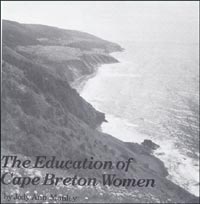|
The Education of Cape Breton Women by Jody Ann Manley
The provision of equal access to education for women is a critical problem. The existence of an educational gap between men and women supports this contention. Recent empirical evidence suggests that the gap is narrowing: between 1970 and 1983 the enrolment of women in universities increased by more that 50 per cent; the comparable increase for men was 17 per cent.(1) Despite this trend, the concentration of women in traditional fields of study, the likelihood that women will participate on a part-time basis, and a lower level of attainment by women show that barriers to equal educational participation persist. Equal access for rural women and those in underdeveloped areas is of particular concern. These women are doubly disadvantaged, facing unique obstacles such as lack of money, distance and poorer quality of education offered. While the removal of barriers for all women is essential, the identification and removal of learning barriers for rural women is even more critical. An assessment of the educational needs of women in Cape Breton provides a unique case study because of the economic and demographic characteristics of the island. Cape Breton has suffered from economic instability for many decades, with many people living in rural communities far from the industrial centre. A study in the summer of 1986 investigated learning barriers particular to Cape Breton with an eye to the development of strategies to overcome them. A questionnaire was sent to 500 randomly selected women living in the various regions of the island. (2) Thirty per cent responded, in part because of follow-up calls to 200 of the women; the telephone call verified that the questionnaire had been received and encouraged participation. The data obtained from the study was analyzed, producing a comprehensive assessment of learning needs. Results Regions represented in the study included Port Hawkesbury, Louisburg, Dominion, Glace Bay, New Waterford, North Sydney, Sydney Mines, Victoria County, Inverness County, Richmond County and the County of Cape Breton. Most respondents were married and under the age of 50. More than half had not completed high school while one-fifth had. Post secondary education or some university was reported by more than one-quarter of the women. Half of the women were employed. One-quarter not employed in the paid labor force, reported receiving financial assistance. One-third indicated that the family income was less than $15,000. More than half indicated a family income of $20,000. A positive attitude toward learning was revealed. More than half indicated that learning was important but not a priority; more than one-third said that learning was a priority. Participants were asked their views on the impact of marital status and children on their education. A majority said that single women with children have the most difficulty; approximately one-quarter thought that married women would experience difficulty. The women were questioned to determine their views on educational television. While some said that they would watch educational television for pleasure or interest, it was not popular as a means of earning a university credit. They preferred to watch educational television in the evening. A majority of survey participants want to take a course. However, more than half said that money was unavailable for such purposes. Women reported being willing to spend $150 on a course and to travel ten miles to participate in educational activity. Most women preferred to take courses between September and December; one-quarter said they would prefer January to March or April to June. The least preferred time was July and August. The majority preferred a one-year course, with one-quarter preferring a one-term course. Learning itself did not seem to be a problem; only one-fifth said that learning was more difficult now than in the past. Most took courses to get information or to prepare for a job. Most women were interested in computer training and stress management. Courses in financial management, assertiveness, first aid, arts and crafts, job-related training and legal rights for women were also mentioned. Obstacles to learning were identified as lack of money, lack of courses, lack of desired courses and lack of information on courses available, inconvenient times and conflict with family responsibilities. Success depended on desire to succeed, personal or financial rewards and the quality of the instructor. |
| Back | Contents | Next |
